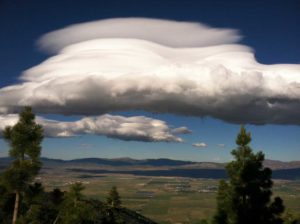 When my nephew Lucas was in fourth grade, he gave me a mobile he’d made for his Earth science class identifying common clouds. Yarn tethered four napkin-sized squares of light blue construction paper to a clothes hanger. On each square, cotton balls had been tortured into puffy or stringy shapes and affixed with generous dollops of glue. His wiggly 9-year-old handwriting identified each cloud type: cumulus, stratus, nimbus and cirrus (which he misspelled as circus, furthering the charm).
When my nephew Lucas was in fourth grade, he gave me a mobile he’d made for his Earth science class identifying common clouds. Yarn tethered four napkin-sized squares of light blue construction paper to a clothes hanger. On each square, cotton balls had been tortured into puffy or stringy shapes and affixed with generous dollops of glue. His wiggly 9-year-old handwriting identified each cloud type: cumulus, stratus, nimbus and cirrus (which he misspelled as circus, furthering the charm).
The mobile thrilled me because I loved Lucas and because in my early 30s a fascination for meteorology had begun to ferment. I didn’t want to be a meteorologist on TV, reading off numbers and gesturing at maps. I wanted to know more about the way weather worked, and clouds appealed to me most of all; they are the eye candy of weather. The mobile took on the depth charge of an omen. I hung it in my living room.
When Lucas gave me the mobile, Miami Beach was home, where I drove a convertible with its top irrevocably stuck in the down position. Every day I drove to my university teaching job under the dome of the mercurial South Florida sky. Above me floated pageants of clouds that looked as if they were stars of Renaissance paintings waiting for tardy cherubs to rest on their majestic billows. Other days angry, grey clouds hurled lightning bolts and hovered over Biscayne Bay like space ships descended to annihilate foolhardy Earthlings.
Necessity is said to be the mother of invention; necessity may have also sired my fascination with the weather and with clouds in particular. To avoid getting drenched while driving, I learned to not only behold the clouds and marvel at their fleeting arrangements; I also learned to read them in efforts to avoid being caught in the rain.
 My cloud fascination led me to Luke Howard, a 19th-century British chemist and amateur meteorologist, who is the Big Kahuna of Clouds. When he wasn’t working as a pharmacist, Howard kept a daily weather journal and saw the need for clouds to have names used by all. He established a codified cloud nomenclature that was accepted by the World Meteorological Association in 1896 and published into the inaugural edition of the International Cloud Atlas, the Bible for cloud enthusiasts.
My cloud fascination led me to Luke Howard, a 19th-century British chemist and amateur meteorologist, who is the Big Kahuna of Clouds. When he wasn’t working as a pharmacist, Howard kept a daily weather journal and saw the need for clouds to have names used by all. He established a codified cloud nomenclature that was accepted by the World Meteorological Association in 1896 and published into the inaugural edition of the International Cloud Atlas, the Bible for cloud enthusiasts.
Howard gave clouds Latin names, zeroing in on primary characteristics: cumulus, which means heap; cirrus, the highest clouds that looked to Howard as if they are “penciled, as it were, onto the sky” and which means curl of hair; nimbus, Latin for rain cloud; and stratus, which means stretched. Those are the big four that Lucas learned. The Cloud Atlas geeks out and divides clouds into 10 genus, 26 species and 31 varieties. There are charts and diagrams and lots and lots of Latin. Species have names like cirrus intortus, a high cloud likened to an entangled lock of hair, and stratocumulus castellanus, a low cloud with a crenellated top resembling the roofline of a fortified castle.
Outside the house where Howard died in England, a plaque identifies him as the Namer of Clouds. I can imagine no more a sublime phrase to ferry someone into history.
 Ten years ago I found a likeminded global posse of cloudspotters, the Cloud Appreciation Society, founded in 2004 by Gavin Pretor-Pinney, a writer and former absinthe importer. Turns out there are thousands of us who take photos of unusual clouds, who keep cloudspotting journals, who catalogue references in music and poetry that wax on about clouds. We are also believers in dreamy headed, aimless gazing. The CAS has its own manifesto that proclaims clouds as poetry, points of meditation and the equivalent of an atmospheric mood ring. As members of the society, we pledge to “look up, marvel at the ephemeral beauty and live life with our head in the clouds.” I consider myself a good soldier for the cause.
Ten years ago I found a likeminded global posse of cloudspotters, the Cloud Appreciation Society, founded in 2004 by Gavin Pretor-Pinney, a writer and former absinthe importer. Turns out there are thousands of us who take photos of unusual clouds, who keep cloudspotting journals, who catalogue references in music and poetry that wax on about clouds. We are also believers in dreamy headed, aimless gazing. The CAS has its own manifesto that proclaims clouds as poetry, points of meditation and the equivalent of an atmospheric mood ring. As members of the society, we pledge to “look up, marvel at the ephemeral beauty and live life with our head in the clouds.” I consider myself a good soldier for the cause.
On July 1, I motored out of Flagstaff on a solo, cross-country road trip. I took two weeks, back roads, detours to parks and forests. My daily sky show was clouds—puffy, summer cumulus clouds sent from central casting with their plump curves and towering columns.
 I drove through Texas and Louisiana and Alabama, thinking about heat and tanned legs and lazy slowness. I thought about how, with smartphones in hand, the world seems to be looking down, enraptured by tiny images of life being lived somewhere else. Look up, I want to say. There’s drama overhead. You don’t need a data plan or a charger. Just look up before it all goes away.
I drove through Texas and Louisiana and Alabama, thinking about heat and tanned legs and lazy slowness. I thought about how, with smartphones in hand, the world seems to be looking down, enraptured by tiny images of life being lived somewhere else. Look up, I want to say. There’s drama overhead. You don’t need a data plan or a charger. Just look up before it all goes away.

